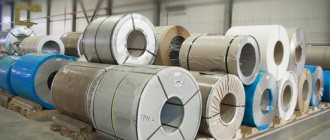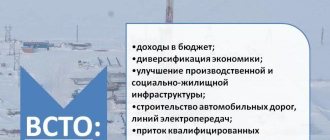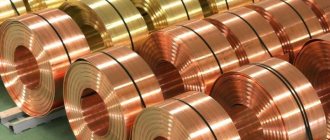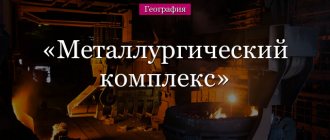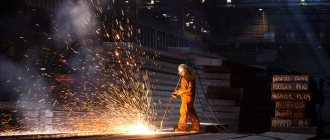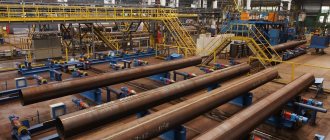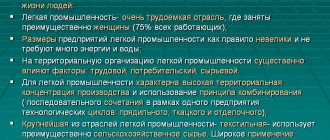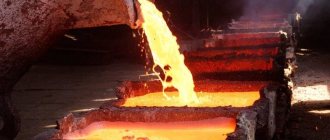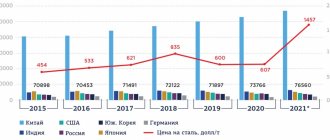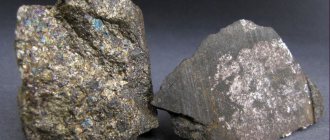The power and prosperity of the state depends on the efficiency of the economy and military potential. The development of the latter is impossible without the development of metallurgy, which in turn is the basis of mechanical engineering. Today the focus is on the metallurgical complex of Russia and its importance for the industrial and economic sphere of the country.
Factors of metallurgy location
The metallurgical complex includes ferrous and non-ferrous metallurgy .
Metallurgy in Russia, providing production and scientific and technical development of almost all industries, is based on domestic raw materials, focusing on foreign and Russian consumers. Russia accounts for 14% of commercial iron ore production and 10–15% of non-ferrous and rare metals mined in the world. In terms of production, consumption and foreign trade turnover, ferrous, non-ferrous and rare metals, as well as primary products from them, occupy second place after fuel and energy resources. Iron ores and primary products of ferrous metallurgy, aluminum, nickel, and copper remain important exports of the country. Large metallurgical enterprises are of regional importance. When they arise, a number of interconnected industries are formed - the electric power industry, the chemical industry, the production of building materials, metal-intensive engineering, various related industries and, of course, transport.
Ferrous metallurgy
Ferrous metallurgy serves as the basis for the development of mechanical engineering and metalworking, and its products are used in almost all spheres of the economy. It covers such stages of the technological process as mining, enrichment and agglomeration of ferrous metal ores, production of refractories, mining of non-metallic raw materials, coking of coal, production of cast iron, steel and rolled products, ferroalloys, secondary processing of ferrous metals, etc. But the basis of ferrous metallurgy is the production of cast iron , steel and rolled products.
Russia, along with the USA, Japan, China and Germany, is one of the top five global producers of ferrous metals. In 2004, Russia produced 105 million tons of iron ore, 51.5 million tons of cast iron, 72.4 million tons of steel and 59.6 million tons of finished rolled products.
The territorial organization of ferrous metallurgy is influenced by:
- concentration of production, in terms of which Russia occupies a leading position in the world - full-cycle metallurgical plants in Lipetsk, Cherepovets, Magnitogorsk, Nizhny Tagil, Novotroitsk, Chelyabinsk and Novokuznetsk produce more than 90% of cast iron and about 89% of Russian steel;
- production combination, meaning the unification at one enterprise of several interrelated industries of various industries;
- material intensity of production, providing 85–90% of all costs for smelting cast iron (the production of 1 ton of cast iron requires 1.5 tons of iron and 200 kg of manganese ore, 1.5 tons of coal, over 0.5 tons of fluxes and up to 30 m3 of recycled water) ;
- high energy intensity, which is higher than in developed countries of the world;
- high labor intensity at domestic metallurgical enterprises.
The production base of ferrous metallurgy consists of full-cycle enterprises: cast iron - steel - rolled products, as well as factories producing cast iron - steel, steel - rolled products and separately cast iron, steel, rolled products related to conversion metallurgy. Small metallurgy, or the production of steel and rolled products at machine-building plants, mainly from scrap metal, is distinguished.
The factors for locating ferrous metallurgy enterprises are extremely diverse. Full-cycle ferrous metallurgy is located either near sources of raw materials (Ural metallurgical base, metallurgical base of the central regions of the European part), or near fuel resources (West Siberian metallurgical base), or between sources of raw materials and fuel resources (Cherepovets Metallurgical Plant).
Pipe metallurgy enterprises, using mainly scrap metal as raw materials, focus on areas of developed mechanical engineering and places of consumption of finished products. Small metallurgy is even more closely connected with machine-building plants.
The production of electric steels and ferroalloys is distinguished by special placement factors. Electric steels are produced near sources of electricity and metal scrap (Elektrostal, Moscow region). Ferroalloys - alloys of iron with alloying metals - are produced in blast furnaces or by electrothermal methods at metallurgical enterprises and specialized plants (Chelyabinsk).
Main factors for locating ferrous metallurgy enterprises*
| Enterprises and production | Placement factors |
| Mining and processing plants | Raw materials |
| Coke and gas plants | As part of full-cycle metallurgical plants |
| Full cycle metallurgical plants | Raw materials, fuel, at sources of electricity and fresh water |
| Particle metallurgy | Gravitates towards mechanical engineering centers |
| Ferroalloy production | Gravitates towards large power sources and full-cycle metallurgical plants |
The natural basis of ferrous metallurgy are sources of metal raw materials and fuel. Russia is well supplied with raw materials for ferrous metallurgy, but iron ores and fuel are distributed unevenly throughout the country.
Russia ranks first in the world in iron ore reserves, of which more than half are concentrated in the European part of the country. The largest iron ore basin is the Kursk magnetic anomaly, located in the Central Black Earth region. The main reserves of KMA iron ores, recognized as the best in the world in terms of quality, are concentrated in the Lebedinskoye, Stoilenskoye, Chernyanskoye, Pogrometskoye, Yakovlevskoye, Gostishchevskoye and Mikhailovskoye deposits. The Kovdorskoye, Olenegorskoye and Kostomuksha fields are exploited on the Kola Peninsula and Karelia. Significant iron ore resources are in the Urals, where deposits (Kachkanarskaya, Tagilo-Kushvinskaya, Bakalskaya and Orsko-Khalilovskaya groups) stretch from north to south parallel to the Ural ridge. Iron ore deposits have been discovered in Western (Gornaya Shoria, Rudny Altai) and Eastern Siberia (Angaro-Pitsky, Angaro-Ilimsky basins). In the Far East, the Aldan iron ore province and the Olekmo-Amgunsky region in Yakutia are promising.
Manganese and chromium reserves in Russia are limited. Manganese deposits are being developed in the Kemerovo (Usinsk) and Sverdlovsk (Polunochnoye) regions, and chromium deposits are being developed in the Perm Territory (Sarany).
Main metallurgical bases
All of the above factors led to the uneven distribution of metallurgical enterprises. Entire metallurgical bases were formed in certain territories. In Russia there are three:
- The central base is a fairly young center, the foundation of which is the iron ores of the Kursk magnetic anomaly region, the Kola Peninsula and Karelia. The main production centers are the cities of Lipetsk, Stary Oskol and Cherepovets;
- The Ural base is one of the largest centers of metallurgy in Russia, the main centers of which are Magnitogorsk, Novotroitsk, Chelyabinsk, Nizhny Tagil and Krasnouralsk;
- The Siberian base is a center that is still in the development stage. The main source is Kuznetsk coal and iron ore from the Angara region and Mountain Shoria. The main center is the city of Novokuznetsk.
A comparative description and operating diagram of metallurgical bases in Russia can be presented in the following table:
| Central | Siberian | Ural | |
| Iron ores | Kursk magnetic anomaly, Kola Peninsula, Karelia | Angara region, Mountain Shoria | Ural Mountains |
| Coking coal | Privoznoy (Donetsk and Kuznetsk coal basin) | Local (Kuznetsk coal basin) | Privoznoy (Kazakhstan) |
| Enterprises | Full cycle enterprises (produce cast iron, steel, rolled products) | Full-cycle and marginal metallurgy enterprises (produce only steel and rolled products) | Full cycle enterprises (produce cast iron, steel, rolled products) |
Answer
Metallurgical complex: composition, main metallurgical bases and factors for locating enterprises. Problems and prospects for development. Metallurgy and environmental problems. The quantity and quality of smelted metal largely determines the economic power of the state.
The industry includes ferrous (mining iron ore, smelting steel, cast iron and ferroalloys) and non-ferrous metallurgy (production of light (aluminium, magnesium, titanium) and heavy (copper, nickel, tin, lead) metals).
Metallurgy heavily pollutes air and water, and the environmental factor becomes the main factor for its location.
To produce 1 ton of steel, 7 tons of ore and coke are needed, so the location of the industry is also influenced by raw materials and fuel factors. New production does not require coke, but requires a lot of electricity, i.e. the energy factor is also important for the industry.
The main bases of non-ferrous metallurgy are Central (around KMA), Ural and Siberian (in the south of Western Siberia).
Ores of heavy non-ferrous metals are characterized by a low metal content in the ore (to smelt 1 ton of copper, 100 tons of ore are needed, 1 ton of tin requires 300 tons), i.e., the main factor of placement is the raw material. Light non-ferrous metals are produced by electrolysis. Therefore, their production is very energy-intensive (to produce 1 ton of aluminum requires 17 thousand kW • h of electricity, and 1 ton of titanium requires up to 60 thousand kW • h). Consequently, the main factor in the location of this production is energy.
General characteristics of the metallurgical complex
What are mining and metallurgical complexes? This is a set of enterprises that are engaged in mining, beneficiation, metal smelting, rolled metal production and processing of secondary raw materials. The following industries are part of the metallurgical complex:
- Ferrous metallurgy , which deals with the smelting of steel, cast iron and ferroalloys;
- Non-ferrous metallurgy , which produces light (titanium, magnesium, aluminum) and heavy metals (lead, copper, tin, nickel).
Rice. 1 Metallurgical plant
Principles of business location
Enterprises of the mining and metallurgical complex are not located randomly. They depend on the following factors of metallurgy location:
- Raw materials (physical and chemical characteristics of ores);
- Fuel (what type of energy must be used to produce metal);
- Consumer (geography of placement of raw materials, main energy sources and availability of transport routes).
Rice. 2 Fuel factor of metallurgy location
What have we learned?
Today we learned what is meant by the term “metallurgical complex”. This industry is divided into ferrous and non-ferrous metallurgy. The location of enterprises for mining, ore beneficiation, metal smelting and rolled products production has its own characteristics and depends on three factors: raw materials, fuel and consumer. There are three metallurgical bases operating and developing in the Russian Federation: Central, Ural and Siberian.
Previous
GeographyForest industry in Russia and the world, location factors and problems
Next
Geography Factors for the location of the chemical industry - table
Non-ferrous metallurgy
Based on their purpose and chemical and physical characteristics and properties, non-ferrous metals are divided into:
- Heavy (copper, lead, tin, zinc, nickel);
- Lightweight (aluminum, titanium, magnesium);
- Precious (gold, silver, platinum);
- Rare (zirconium, indium, tungsten, molybdenum, etc.)
Non-ferrous metallurgy is a complex of enterprises that is engaged in the extraction, enrichment and metallurgical processing of non-ferrous, precious and rare metal ores.
In this chain, aluminum, copper, lead-zinc, tungsten-molybdenum and titanium-magnesium industries are distinguished. In addition, this also includes enterprises producing precious and rare metals.
Features of non-ferrous metallurgy in Russia
They say that if ferrous metallurgy provides the industry with “bread”, then non-ferrous metallurgy provides it with “butter”. The total smelting of all non-ferrous metals (about 70 of them are produced in the country; Fig. 60) is tens of times less than the smelting of steel. But the use of non-ferrous metals in the economy improves the structure of the economy and makes it more progressive. Without non-ferrous metals, it is impossible to produce high-quality steel and semiconductors. They are needed for the production of space technology, catalysts for the chemical industry, automobile filters for purifying exhaust gases, coatings for high-capacity magnetic memory disks and other types of products in the field of latest technologies.
Russia's role is especially large in the global production of aluminum, nickel, copper, titanium, tin and gold.
Non-ferrous metal ores are characterized by low metal content
. Compare: average quality iron ore contains 30-40% iron (rich - 60-70%), and copper ore is considered very rich if it contains about 5% copper. Molybdenum ore contains only a few hundredths of a percent of molybdenum!
Another feature of non-ferrous metal ores is their multicomponent composition
, i.e. they contain several different metals. For example, the Ural so-called “copper” ore also contains nickel, zinc, chromium, other metals and non-metals - sulfur. In this regard, the production of zinc and copper is accompanied by the release of waste - sulfur dioxide. It can be the basis for the production of sulfuric acid. Due to the complex composition of ores, non-ferrous metallurgy “attracts” other industries.
Non-ferrous metallurgy centers in Russia
The centers of the aluminum industry are Bratsk, Krasnoyarsk, Sayansk and Novokuznetsk. Large aluminum smelters located in these cities are developed on the basis of their own raw materials from the Urals, the North-Western region and Siberia, as well as imported ones. This production is quite energy-intensive, so the enterprises are located near hydroelectric and thermal power plants.
The main center of the copper industry of our country is the Urals. Enterprises use local raw materials from the Gaisky, Krasnouralsky, Revdinsky and Sibaysky deposits.
The country's lead-zinc industry depends on the extraction of polymetallic ores, which is why it is located close to their mining sites - Primorye, the North Caucasus, Kuzbass and Transbaikalia.
Rice. 3 Gold mining in Chukotka
Location of non-ferrous metallurgy industries in Russia
The copper industry originated in Russia in the Urals. Over almost 300 years of heavy exploitation, many ore deposits here have been depleted. Nowadays, Ural copper smelters use both local and imported (mainly Kazakh) raw materials.
The largest center of copper-nickel production, Norilsk (Fig. 61), was created in Eastern Siberia in the 1930s. The plant in this polar city produces about half of Russian copper, 1/3 of nickel, almost all of platinum, as well as gold, cobalt and other metals. The activities of this giant of non-ferrous metallurgy, alas, are far from useful for the residents of the city and the surrounding nature. The plant is the largest air polluter in Russia, primarily with sulfur dioxide.
Prospects for the development of the copper industry in Eastern Siberia are associated with a unique deposit of copper ore in the Udokan Range in the north of the Chita region. In terms of ore reserves, it is one of the largest in the world, and the copper content in this ore is high - 1.5%! This deposit is only just beginning to be developed.
End >>>
Problems and prospects
There are problems in every industry. The metallurgical complex is no exception. Among the main problems of ferrous and non-ferrous metallurgy, the following can be identified:
- high energy consumption;
- low capacity of the domestic market;
- high level of depreciation of fixed production assets;
- shortage of certain types of raw materials;
- destruction of the process of reproduction of raw materials and ore reserves;
- technological backwardness and insufficient introduction of new technologies;
- shortage of professional personnel.
But all these issues can be resolved. Russia continues to be a major player in the global metallurgical products market. The share of Russian metallurgy in world production accounts for more than 5% of steel, 11% of aluminum, 21% of nickel, and more than 27% of titanium. The main indicator of the competitiveness of Russian metallurgy on the foreign market is that the country maintains and even expands its export capabilities.

